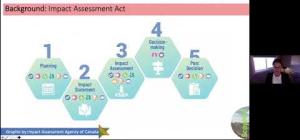
Scoping Population Health in Impact Assessment (ScopHIA): Canada's new Impact Assessment Act

Background: Canada’s New Impact Assessment Act
The Impact Assessment (IA) Act 2019, passed on August 28, 2019, replaced the Canadian Environmental Assessment Act, 2012 (CEA Act) and expands the scope of the federal review process for major natural resource development and large infrastructure projects such as mines, oil and gas fields, dams, and pipelines. The changes under this new law were informed by an expert panel review that addressed perceived shortcomings of the previous legislation in supporting the federal regulatory review process. Under the CEA Act, proponents needed to demonstrate that projects would cause limited harm to the physical environment. In contrast, the IA Act requires that developments are in the public interest and therefore, expands the scope of IAs to give full consideration to positive and negative impacts on health, social, and economic conditions, in addition to assessing environmental impacts. This public interest determination represents new territory for many industrial proponents and potential stakeholder groups in the assessment process, including the public health sector.
This blog examines opportunities for advancing population health equity issues during the planning phase of the IA process, with particular emphasis on the role of public health stakeholders. The findings presented are based on our study: Scoping Population Health in Impact Assessment (ScopHIA) Realist Review: Identifying Best Practices for Equity in Scoping of Major Natural Resource and Large-Scale Infrastructure Projects.
Overview of the IA Act
The IA Act sets out five phases for federal reviews, with legislated timelines for each phase. Each phase has a number of key activities and deliverables, involving the project proponents and the Impact Assessment Agency of Canada (IAAC), the body that oversees the federal IA process and engages with the federal cabinet, federal authorities, other jurisdictions, Indigenous peoples, and affected communities, at various points throughout an IA. The five phases are:
- Planning (180 days)
- Impact Statement (3 years)
- Impact Assessment (300 days)
- Decision-Making (30 days)
- Post-Decision (No time limit)
The Planning Phase
The 180-day planning phase is an important new feature of Canada’s IA system, marking a significant innovation compared to prior Canadian legislation and other national IA systems. At the beginning of the planning phase, all proponents must submit an initial project description for the proposal. The IAAC coordinates between the proponents and Indigenous peoples, affected communities, federal authorities, and other jurisdictions, helping to identify their main concerns and priorities. At the end of the planning phase, the IAAC sets out requirements for the proponents’ activities and deliverables during the remaining four phases, to ensure that the issues raised during the planning phase are addressed. The planning phase provides a crucial opportunity for public health practitioners, researchers, and policy makers to advance population health equity by engaging with proponents and stakeholders from other sectors, conducting primary and secondary research on improving outcomes, and/or providing overall guidance and policy direction to the impact assessment process. This includes addressing direct health impacts and those mediated through various determinants of health on communities and individuals who may be adversely affected and those who may benefit from proposed projects.
The ScopHIA Realist Review
The ScopHIA study employed a realist review to synthesize evidence and recommend evidence-based best practices and principles for promoting population health equity during the earliest stages of federal reviews for major projects under Canada’s new IA system. The researchers extracted data from 185 documents obtained through purposive searching, and retrieving articles containing the keywords “health” and/or “scoping” published in the journals Impact Assessment & Project Appraisal and Environmental Impact Assessment Review, between 2010 and 2019. Data were extracted under three themes: (i) Health Factors as Valued Components, (ii) Multiple Value Systems and Ways of Knowing, and (iii) Building Capacity for Engagement and Partnerships. All of the evidence was reviewed and mapped to key activities and deliverables in the planning phase. Findings with the greatest relevance to public health professional practice fall into three categories:
Supporting Indigenous peoples in participatory processes. Public health stakeholders can support and advocate for adequate resourcing of Indigenous governments and boundary organizations to facilitate more meaningful consultation on health and determinants of health, including environmental, social, and economic concerns. Many new natural resource and infrastructure developments operate on or near the traditional territories of Indigenous peoples, in relatively remote regions of Canada. In these regions, land and natural resources are important for self-determination, livelihoods, food harvesting, and cultural practices and impacts in these areas have heightened ramifications for Indigenous communities.
One example of participation during the planning stage is the Makivik Corporation's interpretation of oral testimony from Inuit Elders in terminology suitable for developing IA guidelines during the scoping for the proposed Great Whale Hydroelectric project in Nunavik (northern Québec). Community-based research and development processes can also support the generation of meaningful indicators, models, and thresholds. For instance, the First Nations Major Project Coalition notes the importance of sensory values such as taste, smell, visual, and aural landscapes for understanding population health equity impacts of projects. Direct engagement of Indigenous peoples and affected communities during the planning phase increases the likelihood of incorporating these perspectives and values.
Engaging with affected communities to identify concerns. Choosing tools and frameworks that encourage engagement and participation may be factored into the planning stage. For example, Health Impact Assessment (HIA) has strong equity roots and is designed to integrate determinants of health. The Alaska Health Impact Assessment Program provides an illustration of an application that employs dedicated public health physicians and epidemiologists to support regional IAs. It also maintains an excellent collection of related public health resources and the program's Health Effects Categories framework summarizing concerns in eight areas: (a) social determinants of health, (b) accidents and injuries, (c) exposure to potentially hazardous materials, (d) food, nutrition, and subsistence activity, (e) infectious disease, (f) water and sanitation, (g) non-communicable and chronic diseases, and (h) health services infrastructure and capacity.
Collaborating with federal authorities in public health. Federal authorities in public health serve important roles in the Canadian IA system. Their work includes providing advice to support project-level analyses (Health Canada), conducting knowledge translation to increase professional competency and promote field development (e.g., Public Health Agency of Canada's National Collaborating Centres for Public Health program), and funding research to improve practices and understand health outcomes (Canadian Institutes of Health Research). Informed by this work, the IAAC can advance consideration of population health equity issues during the planning phase by collaborating with regional public health stakeholders to understand community health baselines, health system capacity, public health surveillance systems, and intersectoral information such as levels of income, access to education, or transportation systems. Although these collaborations may be important at any phase of an IA, the planning phase is especially important for identifying data, agencies and resources that may be required in later stages.
Summary
The new IA Act provides a strong decision-making mandate for incorporating health in federal reviews and demonstrating that proposals are sustainable and in the public interest. Given the scale and complexity of large natural resource and infrastructure developments, public health practitioners, researchers, and policy makers can play a critically important role in advancing population health equity under this mandate. The 180-day planning phase provides important opportunities for early involvement of public health professionals in engaging Indigenous peoples and/or affected communities, identifying their concerns and requiring proponents to address the issues raised over the course of the IA process. Agencies in the public health sector can connect with IAAC to learn more about major project proposals in their jurisdictions, and support the aims of the planning phase by contributing skills and expertise in community engagement and health equity, and familiarity with health frameworks, data, and intersectoral collaboration.
This blog is one of two addressesing the relevance of changes to the IA process under the IA Act. The second blog, Health impact assessments for natural resource and large infrastructure developments-Opportunities for public health focuses on opportunities and gaps for public health practitioners and options for addressing these gaps.
Additional Resources
- Anderson, P.J., Yoder, S., Fogels, E., Krieger, G. & McLaughlin, J. (2013). The State of Alaska’s Early Experience with Institutionalization of Health Impact Assessment. International Journal of Circumpolar Health. 72.
- Doelle, M. & Sinclair, A.J. (2018). The New Federal Impact Assessment Act in Canada: Delivering on Reform Expectations? [Working Paper].
- Jagosh, J. (2019). Realist Synthesis for Public Health: Building an Ontologically Deep Understanding of How Programs Work, For Whom, and In Which Contexts. Annual Review of Public Health. 40:361-372.
Funding Acknowledgement: Funding for our study was provided by the Informing Best Practices in Environmental and Impact Assessments Knowledge Synthesis Grant program launched by the Social Sciences and Humanities Research Council of Canada and Impact Assessment Agency of Canada in mid-2019.
Jennifer Ann Brown is a doctoral candidate at the School of Public Health, University of Alberta studying population health equity in impact assessments, recognized with research scholarships from the Canadian Institutes of Health Research (2017-2020) and Alberta Innovates (2020-2022). She has presented her work on impact assessment in forums such as the International Congress on Circumpolar Health, Arctic Science Summit Week, and the International Association for Impact Assessment, co-authoring several articles on healthy public policy in journals such as Social Science & Medicine, Environmental Science & Policy, and Preventive Medicine Reports.
Candace I. J. Nykiforuk is a Professor and Director of the Centre for Healthy Communities in the School of Public Health, University of Alberta, and part of the Core Committee for Alberta Health Services’ Population, Public and Indigenous Health Strategic Clinical Network. She is a member of the the Royal Society of Canada's College of New Scholars, Artists and Scientists (2016-2023), and leads several multi-jurisdictional collaborations on healthy public policy research, with extensive experience engaging target research users to co-create impactful research products.








